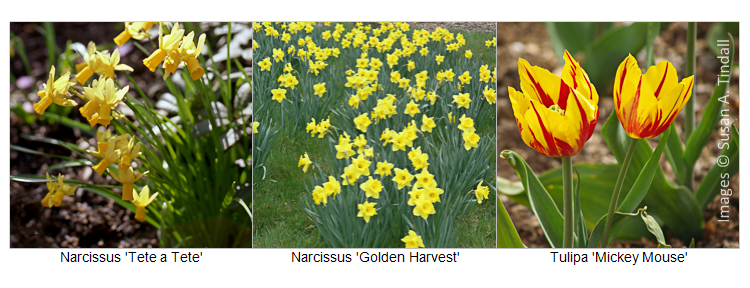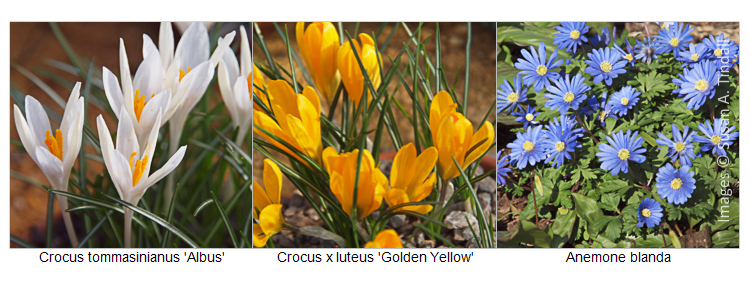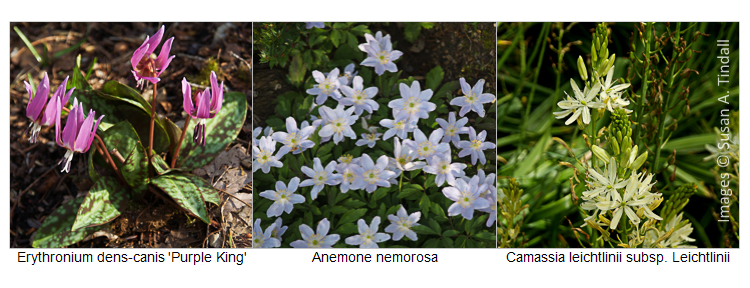This is the time of year when colourful packets of spring bulbs appear on the shelves. The pictures of all those perfect flowers are alluring and the idea of them appearing in your garden can be irresistible. Think about your garden and how you can add to its spring appeal by procuring the right bulbs.
Do you want to fill a few containers for a splash of colour? Perhaps these could be placed outside the front door, outside a window, or grouped on the patio. Maybe you want a substantial display of colour. Perhaps you would like a hundred or more daffodils or tulips to strut their stuff in one area. Your preference may be for a few colourful incidents, scattered about the garden to enliven beds that appear dull and empty during spring. There may even be a rockery or raised bed, or perhaps a permanently shady place that would benefit from some colour in spring. Possibly, you find that you want bulbs for all of these places!
For big displays daffodils or perhaps tulips are the obvious choice. When planted in wild-looking areas simple flowers work better than complicated double ones. Flowers on long stems look better than, for example, small daffodils like the otherwise delightful Narcissus ‘Tete a Tete’ which can look lost in a large setting. Robust trumpet daffodils like Narcissus ‘Golden Harvest’ are excellent grown en masse. For something elegant and appealing the snowy purity and refinement of Narcissus ‘Actaea’ may be attractive. Tulips grown en masse can look better if planted in a formal group with clean edges to make a crisp contribution. Try the bold and lively single-cupped Tulipa ‘Mickey Mouse’, coloured rich yellow with red flashes, adding an exotic touch.

If you wish to create areas of interest, perhaps around deciduous shrubs that look bare in winter, you may choose to create carpets of crocus. It may be necessary to buy several packets to make a show. If left to their own devices they should gently spread over the years. The best effects are achieved with the use of a single variety if you are generally looking at them from a distance. White and yellow will show up more clearly than purple. The simple white Crocus tommasinianus ‘Albus’ is generally reliable, or try the confident golden yellow of Crocus x luteus ‘Golden Yellow’. When the flowers open they resemble the goblets of magnolia. Colonies of Anemone blanda, with its blue, white or pink daisies are a delight, though they may fail to establish themselves.

Those who have a rock garden or a raised bed can plant some of the small exquisite bulbs that are often sold in threes. The enchanting ice blue of the tiny Iris ‘Katharine Hodgkin’captures many hearts. If you have a warm south-facing spot the chunky blue pyramid of the Cuban lily, Scilla peruviana is a plant to cherish, whilst small daffodils such as the dainty sweet-scented Narcissus ‘Minnow’ or the starry yellow flowers of ground-hugging Tulipa tarda could be tried.

For permanently shaded places the strangely named dog’s tooth violet with mottled foliage and curious flowers with bowed heads and swept back petals can be an aristocratic addition. Try the modest Erythronium dens-canis ‘Purple King’ or the pale yellow Erythronium ‘Pagoda’. You may even be able to establish a drift of the delightful wood anemone Anemone nemorosa or one of its forms.

Finally, if you have an area of grassland or grow wild flowers that are only cut back after midsummer, you may be able to establish a colony of the stately Camassia, such as tall Camassia leichtlinii subsp. Leichtlinii which adds distinction to any garden.
There are many more possibilities than can be explored here.
Enjoy
Susan A. Tindall
Details of these and many other bulbs are available from the Garden for pleasure plant finder.

